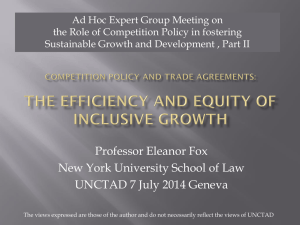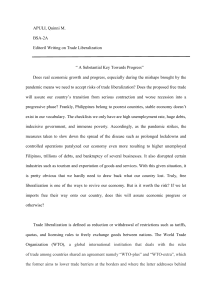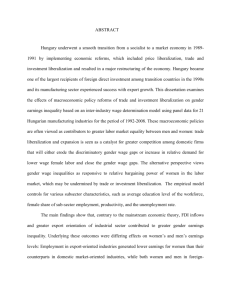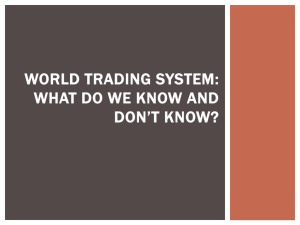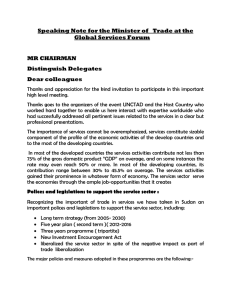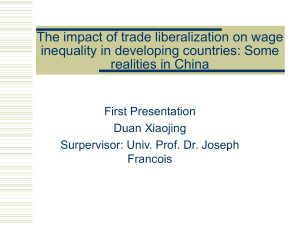Ad Hoc Expert Group Meeting on
advertisement
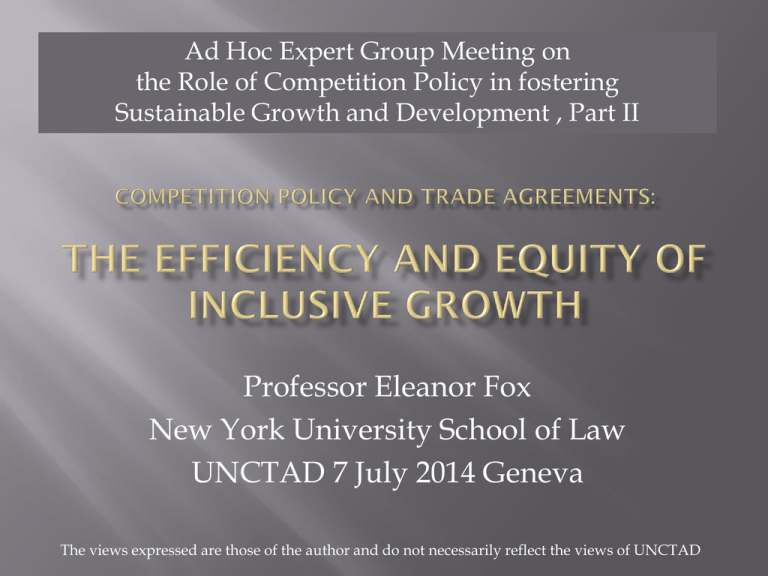
Ad Hoc Expert Group Meeting on the Role of Competition Policy in fostering Sustainable Growth and Development , Part II Professor Eleanor Fox New York University School of Law UNCTAD 7 July 2014 Geneva The views expressed are those of the author and do not necessarily reflect the views of UNCTAD 1. The new consensus on growth & development – we need inclusive growth and development Relevance of recent inequality literature 2. Looking at the trade agreement clauses through the eyes of developing countries seeking efficient sustainable growth and development i. liberalization ii. global value chains iii. IP rights iv. competitive neutrality 3. Conclusion 2 Myth: Arthur Okun, Equality and Efficiency, The Big Trade-Off (1975) For almost 40 years “everyone knew that doing anything to reduce inequality would have at least some negative impact on GDP.” But “what everyone knew isn’t true. Taking action to reduce extreme inequality … would probably increase, not reduce, economic growth.” Paul Krugman, March 10, 2014, NYT, re IMF reports 3 Literature Picketty, Capitalism Rodrik, The Globalization Paradox Acemoglu/Robinson, Why Nations Fail Sliglitz, The Price of Inequality How this is relevant If increasing aggregate economic wealth in the world has been a goal of antitrust/free trade Developing countries need a counter-perspective: Robust markets open to competition on the merits by those without power For an inclusive–growth view, we look at trade agreements thru eyes of developing countries 4 Trade liberalization helps make markets work Benefits to developing countries are not automatic – need institutions, infrastructure, skills Some liberalizations are more pro-development than others Martin Wolf – The Hypocrisy of the Rich The developed nations pick and chose what to liberalize Where developing countries need liberalization the most they are not sure to get it Lifting cotton subsidies; market access for textiles A special competition challenge: Liberalization facilitates international cartels, mergers that may be harmful to developing countries 5 Enabling global value chains is liberalization They are proliferating; they are in theory good for sustainable inclusive development Economic opportunity for producers and consumers They are changing patterns of competition and incentives -- effect on competition to be watched Might they exploit and unreasonably exclude? Competition law as an instrument to protect against anticompetitive exclusion and monopsony (but not usually a violation) South Africa – use of merger approval for safeguarding public interest in building capacity of local suppliers 6 IP protection is important for investment but .. Further protections are not necessarily important for innovation and can be bad for development Developed countries are driving hard bargains for protections beyond TRIPS Are including in their bargaining agendas even more protection than they get at home Even in developed countries It is widely recognized that the balance between patent protection and competition too friendly to IP Competition enforcement limiting IP–FRAND, generics 7 Principle: No competitive advantage to government business simply because it is state-owned Clauses are in some trade agreements, especially with Australia; proposed in TPP Eg anticompetitive activities of sub-federal enterprises not to be excluded from antitrust laws Competitive neutrality is symbiotic with competition; sympathetic to developing country needs for growth and development and equity for the entrepreneur without political connections The worst restraints are often by government and its cronies, who close markets by privilege and corruption 8 1. The aim is INCLUSIVE growth and development 2. This means a consciousness that the new clauses in trade agreements should look in the direction of the non-powerful Benefits that disproportionately and consistently favor the rich, the powerful, the enabled, the well-connected need counter weight For competition and trade policy what does this mean? Opening markets with fair and free access and a lean against privilege and entrenchment In this light we can assess What are the best measures of liberalization, GVCs, IP protection, and competitive neutrality 9
